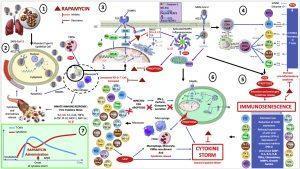One of the hallmarks of COVID-19 immunopathology is cytokine release syndrome (CRS) and T cell dysfunction (read articles below). These immune functions are partly triggered by SARS-CoV-2 activation of the mTOR pathway. Omarjee et al., describe the potential immuno-therapeutic utility of rapamycin (mTOR inhibitor) against COVID-19, a drug that is currently being tested in a phase 2 trial in USA (NCT04341675). Rapamycin treatment has been shown to successfully reduce the recovery time for H1N1 and SARS patients (Wang et al., 2014), thus providing evidence for rapamycin treatment against immunopathology due to severe respiratory viral infections.
In an elegant infographic, they describe various immune pathways which could be targeted by rapamycin and lead to the down-regulation of inflammatory cytokines (inhibition of CRS), resulting in a micro-environment that does not favour prolonged T cell exhaustion and prevents to T cell dysfunction.

Rapamycin use in COVID-19. ①SARS-CoV-2 entry into lungs through respiratory droplets ②Alveolar (Type II) Epithelial cell zoomSARS-CoV-2 bindingACE2 and entry into Alveolar (Type II) Epithelial cell SARS-CoV-2 replication into Alveolar (Type II) Epithelial cell Cell apoptosis releasing DAMPs Innate immune cells recruitment ROS releasing Innate immune response with chemokines and cytokines release ③ DC Zoom Binding SARS-CoV-2 to TLR Activation of NFkB signaling pathway Activation of PI3K/AKT/mTOR signaling pathway Activation NLRP3 inflammasome pathway by the ROS as result of SARS-CoV-2 binding ACE2 Production of IL-1β by Caspase-1 from pro- IL-1β Caspase-1 mediate cell pyroptosis Rapamycin blocks mTOR and finally limits IL-1β and IL-6 production as well as pyroptosis ④ Preferential differentiation of ETC, TH1 and TH17 by activation of mTORC1 pathway by ROS ⑤ ROS, Pyroptosis, extensive and prolonged cytokines release lead to immunosenescence Expression of senescent markers such as PD-1 Senescent Associated Secretory Phenotype (SASP) with IL-1, IL-6, IL-8, TNFα, Chemokines, MMPs, and Growth Factors ⑥ Critical phase of SARS-CoV-2 infection with Cytokine Storm and immunoscenescence SASP and Pyroptosis lead to Macrophages, Monocytes, PMNs recruitment and cytokines release. SASP, Pyroptosis, and cytokines released by Macrophages, Monocytes, and PMNs are the main components of CYTOKINE STORM CD8+ T lymphocytes senescence under cytokine storm and extensive SARS-CoV-2 replication : Cytokine storm increases the numbers of STC expressing the senescent marker PD-1 PD-1+ STC become unable to secrete IFN-γ, Perforin, and Granzyme, and eventually kill the infected cell ⑦ Kinetics of SARS-CoV-2 infection and window of opportunity for rapamycin treatment Abbreviations: DAMPs: Damage Associated Molecular Paterns; PMNs : Polymorphonuclear Leukocytes ; ROS: Reactive Oxygen Species; DC : Dendritic Cell ; TLR : Toll Like Receptor ; ACE2 : Angiotensin Converting Enzyme 2; MAVS : Mitochondrial Anti-Viral Signaling; STC : Senescent T Cell; ETC: Effector T Cell; MTC: Memory T Cell; ARDS : acute respiratory distress syndrome. (Source: Omarjee et al. 2020)
Journal Article: Omarjee et al., 2020. Targeting T-cell senescence and cytokine storm with rapamycin to prevent severe progression in COVID-19. Clinical Immunology
Other Articles:
- Cytokine Release Syndrome & COVID-19
- COVID-19 – Cytokine storm syndromes and immunosuppression
- Can the Cytokine Release Syndrome in COVID-19 patients be treated using CCR5 blocking antibody therapy?
- Aging & COVID-19
Summary by Cheleka AM Mpande










